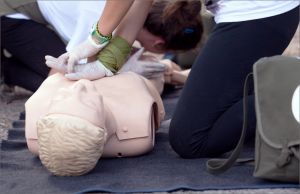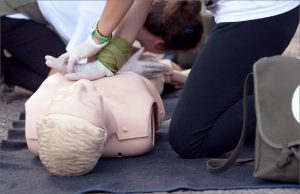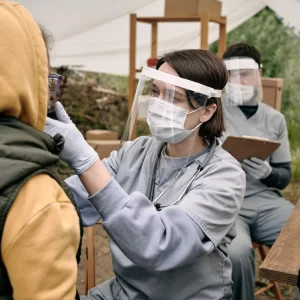 CPR Training Saves Lives During Sudden Cardiac Arrest
CPR Training Saves Lives During Sudden Cardiac Arrest
Critical care medicine takes place anywhere, and that includes in austere environments, remote settings, in urban locations, and during emergencies.
Those trained in cardiopulmonary resuscitation (CPR) help save life especially when someone has sudden cardiac arrest. During this event, the heart fully stops beating or functions erratically.
When someone ceases to breathe and the heart stops functioning, CPR provides critical care prior to arrival of first responders. The minutes between life and death are a goldmine to emergency paramedics and physicians. Getting trained in proper CPR is the difference between life and death; this is not a cliche.
What Is Abnormal Heart Rate
In a healthy adult, the customary resting heart rate centers around 60 beats per minute. For fit athletes, their heart rate may be 40 to 60 beats per minute. Anxiety, stress, exertion or exercise causes the heart rate to increase, while meditation, sleep and rest cause the heart rate to decrease.
When the heart pumps faster due to external factors like caffeine, chemicals or anxiety, people feel poorly. Experts say that consistent heart rates above 100 beats per minute and higher cause tachycardia.
People who consistently have higher heart rates, usually over 100 beats per minute, should consult their doctor to determine the cause of a faster heart rate.
What is Cardiac Arrest
When someone undergoes cardiac arrest, the heart beats erratically or not at all. When the heart stops beating, blood no longer circulates throughout the body’s organs.
In particular, when the brain suffers from lack of blood flow, irreparable and irreversible damage may occur. If someone performs CPR within three minutes, the brain may survive; however, after nine minutes, brain damage likely occurs. This damage is known to be irreversible.
What Happens During CPR
Cardiopulmonary resuscitation manually pumps blood for a non-beating heart. During cardiac arrest when the heart ceases to function, CPR provides a method for the manual pumping of the heart. This manual, systematic compression on the heart enables blood to continue circulating and allows the circulatory system to continue working. With a beating heart, the rest of the body’s systems also continue to function.
A person trained in CPR may also administer rescue breaths in between compressions. When the heart stops, breathing also ceases. The rescue breaths help deliver air into the lungs. Without a beating heart, oxygen no longer moves throughout the body and lungs deflate.
The American Heart Association emphasizes the importance of compressions during CPR more than rescue breaths. The circulation of oxygen is more critical during CPR than adding more oxygen to the victim’s lungs.
When trained in proper CPR, rescue breaths should be administered at a rate of two breaths for every 30 compressions for adults. For children or babies, administer two rescue breaths for every 15 compressions. Pause only a short time to administer rescue breaths and continue compressions until first responders arrive at the scene. When administered quickly, CPR doubles and perhaps triples survival rates for those in settings outside hospitals or emergency rooms.
Sudden Cardiac Arrest and CPR
Sudden cardiac arrest occurs in homes, schools and workplaces with often inaccessible medical care. People trained in CPR provide the missing link especially when medical professionals are not nearby. As mentioned above, after nine minutes without oxygen, the brain suffers highly consequential damage.
Victims of sudden cardiac arrest have more opportunity to live when a bystander or medical provider administers CPR. Those with CPR training are empowered to assist and save lives during critical incidents. Those without the training stand by helplessly.
The value of CPR to a victim holds no bounds. Circulation of blood from the heart to all organs helps prevent damaging consequences. Moreover, survival rates increase when CPR is administered.
CPR training is an investment for everyone. No one knows when sudden cardiac rest will occur. Having trained medical or non-medical personnel jump in to administer CPR truly is a matter of life or death.
8. CPR Makes Work Safer
There are about 10,000 cardiac arrests in the workplace each year in the United States. Workplace safety is vital for any business. Numerous companies are now training employees in CPR to ensure help is available in the office if a Sudden Cardiac Arrest should occur. When workers have First Aid and CPR training, they help reduce workplace accidents and can even save lives at work. Investing in CPR training for employees shows workers that the company cares about their health and well-being.
9. You May Learn How to Use an AED During a CPR Class
Many CPR classes include AED training. AED shock delivery is a key link in the chain of survival. AEDs are specifically designed to be easy to use but training can provide additional confidence and potentially save precious moments in an emergency.
10. Anyone Can Learn CPR
Fortunately, there are only a few simple things you need to remember in order to recognize SCA and save a life. There are quick and inexpensive CPR classes throughout the United States.
11. You May Learn How to Use an AED During a CPR Class
Many CPR classes include AED training. AED shock delivery is a key link in the chain of survival. AEDs are specifically designed to be easy to use but training can provide additional confidence and potentially save precious moments in an emergency.
12. Anyone Can Learn CPR
Fortunately, there are only a few simple things you need to remember in order to recognize SCA and save a life. There are quick and inexpensive CPR classes throughout the United States. Reach Alleanza to learn more about CPR.


